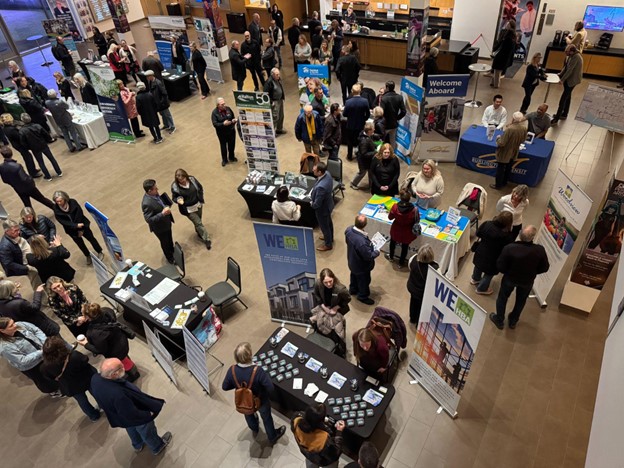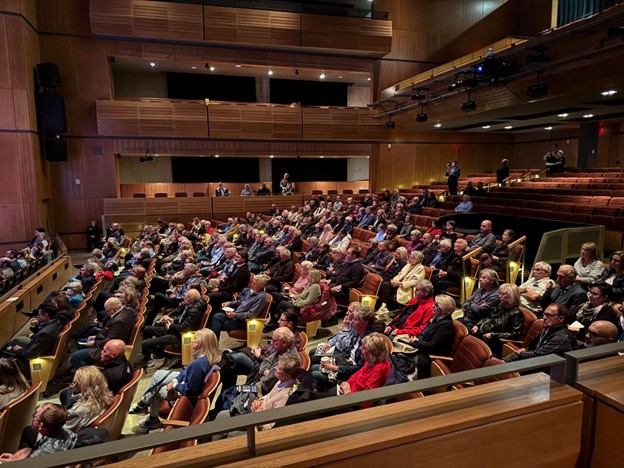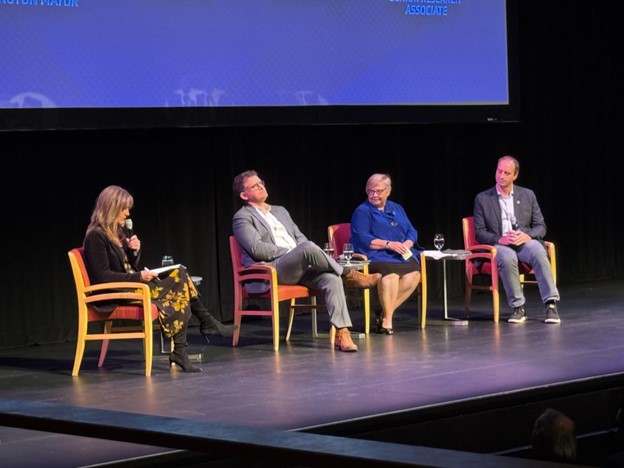By Jack Brittle, Local Journalism Initiative Reporter
On November 12, Burlington Mayor Marianne Meed Ward held an event at the Burlington Performing Arts Centre (BPAC) where she was joined by three guest speakers to discuss the anticipated population growth coming to the city over the next few decades.
The event was part of the Mayor’s Speaker Series titled “Innovation To Action.”
Before the talk began in the auditorium, several community organizations gathered in the foyer with stations set up that attendees could visit to learn more about them and their services.
Robin Bailey, executive director of the Burlington Food Bank, and Krista Kay, the director of marketing and community fundraising for the agency, were present at their station. Bailey spoke about the effect that the population increase will have on their organization.
“As the city grows, obviously the percentages of those who need our assistance don’t really change,” Bailey said. “And that percentage right now is around 11% or so. So in a city of 200,000, you’re looking at 20,000 people. As the city grows, that number just keeps going up. It’s really important for us to be on the front edge of that and to make sure we’re building an infrastructure that’s there to support those who are going to need our services not only now, but down the road as well.”

The three guest speakers at the talk were Jeff Neven, CEO of Indwell, Terri Johns, an urban planner as well as president and founder of Landwise, and Jesse Helmer, a senior research associate at the Smart Prosperity Institute.
Before bringing the three speakers out, the mayor narrated a slideshow that provided residents with statistics relevant to how Burlington is doing right now and what to expect in terms of numbers from the forecasted population growth.
According to the slides, Burlington is expected to grow by 265,000 people by 2051. Meed Ward also referenced numbers regarding transit ridership including the fact that it is up by 40% among seniors and that 3.1 million trips are completed per year. Last year, the city made Burlington Transit free for seniors and for youth on evenings and weekends.
The mayor also noted that one of the reasons why we may see more population growth than some other neighbouring communities is the fact that Burlington is routinely ranked as one of the best places to live in Canada and Ontario.
Helmer then spoke about how the population is increasing all over the country, and the fact that large swaths of Canadians are retiring now or in the near future, which presents a need for immigrants to drive Canada’s economic growth.
Meed Ward also mentioned that the province has allocated 25,000 of the 1.5 million new housing units they are building over the next 10 years to Burlington.
Neven spoke about the impact that housing affordability will have on new residents.
“Here in Burlington, the median household income is $110,000,” Neven said. “When I look at prices of the cheapest new housing units being built, you need to have a household income of at least $120,000 plus savings in the bank in order to be able to purchase that. So that means that half of households right here in Burlington can’t buy even the cheapest condo.”
“When we look at homelessness across North America, one thing is very clear,” he continued. “The higher the housing price, the higher the rate of homelessness.”

Meed Ward said that during the period of expected growth, the city must ensure everyone is taken care of.
“We need to accommodate and think about a whole range of housing options so people that have different incomes don’t feel the need to leave our city,” Meed Ward said. “We want to make sure that they’re not left behind with this growth.”
Neven also spoke about a way to alleviate these affordability issues.
“Let’s have some hope,” Neven said. “And I think the hope is, we have a window. We have a window of opportunity here where our construction workers are looking for work and where prices are coming down for the cost of building new construction.”
“And so I hope we use this opportunity, and I hope we use that not only here in Burlington, but across the region,” he continued. “That we create thousands and thousands of units of non-profit housing to make sure that people don’t end up under a tarp.”
Correction notice: the name of the event was corrected to “Innovation To Action.” Our apologies for any inconvenience caused.





